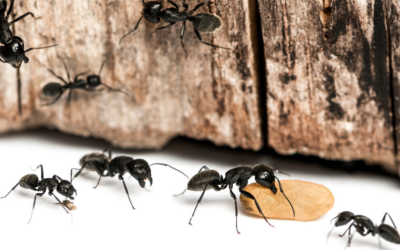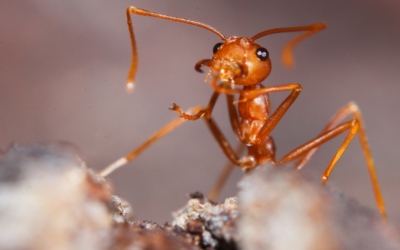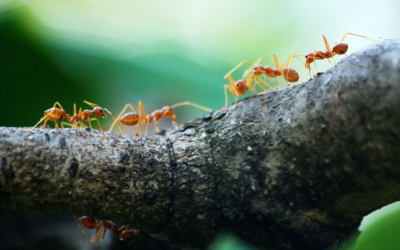Texas is home to a diverse array of insect species, including the fascinating long skinny ants that capture our attention. This blog will explore the world of long skinny ants in Texas. We will focus on one species in particular: the odorous house ant (Tapinoma sessile). Join us as we uncover the mysteries surrounding these ants, their characteristics, behaviors, and how to address any potential infestations.
Meet the Odorous House Ants
These house ants are the long skinny ants commonly found in Texas. These ants are relatively small in size, ranging from light to dark brown in color. What distinguishes them from other ants is their unique odor. When crushed, odorous house ants emit a strong, unpleasant smell reminiscent of rotten coconut or blue cheese.
Characteristics
- Appearance: Odorous house ants have a slender body shape, with workers measuring about 1/16 to 1/8 inch in length. They feature a segmented body consisting of a head, thorax, and abdomen. Their antennae are composed of 12 segments and lack a distinct club-like structure at the tip.
- Coloration: The coloration of odorous house ants can vary from light brown to dark brown. Their bodies are typically uniform in color, lacking distinct markings or patterns.
- Odor: As their name suggests, odorous house ants release a pungent odor when disturbed or crushed. This odor helps distinguish them from other ant species and can be a useful identifying characteristic.
Habits and Behaviors of Odorous House Ants
- Food Preferences: Odorous house ants are omnivorous scavengers. Animals have a preference for sweet and sugary substances. Examples include honeydew produced by aphids, fruits, sweets, and syrups. They are also known to feed on dead insects and household food scraps.
- Nesting and Colonies: these house ants typically nest outdoors under rocks, in mulch, or in soil. However, they are opportunistic and will readily establish nests indoors, particularly in areas with accessible food and water sources. Their colonies can consist of multiple queens and numerous worker ants.
- Foraging Patterns: These ants form distinct foraging trails as they search for food. They can traverse long distances and follow pheromone trails laid down by scout ants to locate food sources. Their small size gives them access to even the smallest crevices and gaps. This makes it difficult to stop them from entering buildings.
Identifying Odorous House Ants on Your Property
Recognizing odorous house ants is crucial in identifying potential infestations on your property. Here are some key characteristics to look for:
- Size and Body Shape: Odorous house ants are small, measuring about 1/16 to 1/8 inch in length. Their bodies are elongated and slender, with a distinct segmentation.
- Coloration: They vary in color from light brown to dark brown, and their bodies typically lack any noticeable patterns or markings.
- Odorous house ants have a distinctive feature: a strong, unpleasant smell. It is similar to the smell of rotten coconut or blue cheese when they are crushed. This odor is often a telltale sign of their presence.
Dealing with Odorous House Ant Infestations
Preventing and managing odorous house ant infestations can help protect your property. Here are some effective strategies:
- Cleanliness and Sanitation: Keep your living spaces clean and free from food debris, spills, and crumbs. Wipe down surfaces regularly, especially in the kitchen and dining areas, to eliminate potential food sources.
- Seal Entry Points: Inspect your property for cracks, gaps, and openings that serve as entry points for ants. Seal these openings with caulk or other appropriate sealants to prevent their access.
- Address any moisture issues, such as leaky pipes or faucets. Odorous house ants are attracted to damp environments. Eliminate these moisture sources to prevent ants from entering your home. Ensure proper ventilation and promptly fix any water-related problems.
- Trim Vegetation: Maintain a clear perimeter around your property by trimming vegetation, trees, and shrubs. This minimizes the likelihood of ants using these as bridges to access your home.
- It is advisable to consult with a professional pest control service if you have a persistent odorous house ant infestation. They have the expertise to identify the extent of the infestation, develop customized treatment plans, and offer long-term prevention strategies.
Ensure Effective Management
The long skinny ants commonly found in Texas, known as odorous house ants, captivate us with their unique characteristics and behaviors. Recognizing their appearance, distinctive odor, and nesting habits can help identify and address potential infestations.
Practicing good sanitation can reduce the risk of odorous house ant infestations on your property. Seal entry points to further reduce the risk. Additionally, reduce moisture sources to decrease the chance of infestations.
Schedule a free inspection with 855Bugs to ensure effective management and long-term prevention. Stay vigilant and maintain a pest-free environment to protect your home from these intriguing yet potentially bothersome insects.




